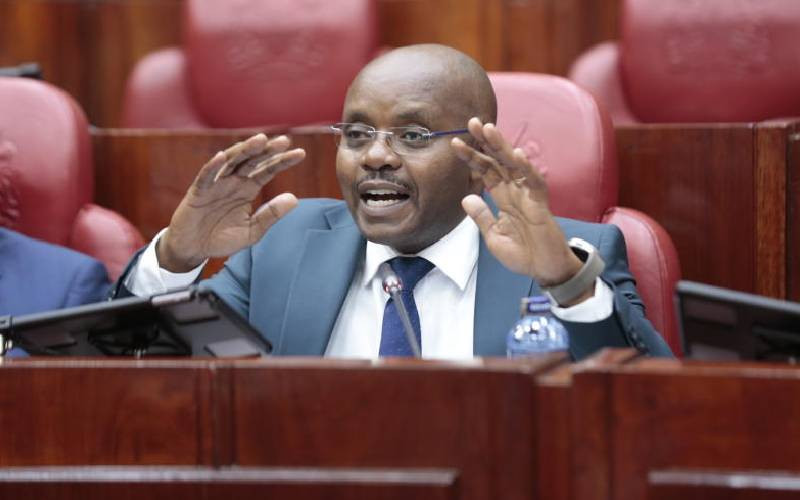Kenya's banking sector is ill. Of that there can be no doubt: not when two respected banks have fallen into administration in the last year or so; not when interest rates have touched 25 per cent; not when there turned out to be more non-performing loans than we had expected; and certainly not when bank directors seem immune to term limits.
The National Assembly has stepped in, with a Bill to cap interest rates. It remains only to ask whether the medicine proposed actually cures the illness.
Liberalisation in finance has been a great success. It is not just that it made foreign finance easier to obtain – often at better rates than were on offer in Kenya. It also closes off avenues for corruption.
It should never be forgotten that the Goldenberg scandal was made possible by the Government's attempts to artificially set prices for exports. Essentially, Government paid exporters a better price for their exports than they could secure in free markets. Disaster followed.
The abolition of price controls was one of the great successes of liberalisation. Another, very rarely remarked upon, was this: the success of multiparty democracy. Our democracy depends on liberalisation. Only once the banking sector in Africa had been freed from the grip of Government could opposition parties finance themselves, to build the coalitions that would hold Government accountable – and eventually win power.
Perhaps the clearest exposition of this point is Leonardo Arriola's Multi-ethnic Coalitions in Africa: Financing of Opposition Election Campaigns. As he shows at some length, Kenya's opposition was finally able to take power in 2003 because much of our business and finance had escaped close State control. Kenyan businesses and banks could support the opposition without serious fear of direct reprisal.
To propose the return of price controls – for that is what the proposed cap on interest rates amounts to – is to propose a return to the bad old days. It is a return to an unacceptable level of Government control of Kenya's financial sector. And, worse, it is the wrong medicine, for it will not – it cannot – solve the problem.
What accounts for Kenya's high interest rates? The inordinate market power of a few key players. In a fascinating piece of research published in 2014, Maureen Were of the Central Bank's School of Monetary Studies showed that it was the six biggest banks in Kenya, controlling more than half of total loans, which had the biggest spreads between deposit and interest rates. Indeed, the larger the bank, the wider the spread.
So would capping interest rates reduce the market dominance of the big banks? It would not. Indeed, since it would make money somewhat tighter, it would only favour them. And, doubtless, they would use their dominance to recapture any losses that would follow as a consequence of the capping of interest rates.
The second point to make is that a key reason why interest rates are high is Government borrowing. Yet again, capping interest rates does nothing to lower government borrowing.
Indeed, capping interest rates through Parliament is akin to a borrower telling a banker the rate at which he must lend. We ought to allow banks to assess the risk presented by a given borrower, even if that borrower is government.
It is not the government's job to tell the banks the price at which they will lend money. Price controls of that kind are not just ineffective; they are an open invitation to corruption.
But we need to insist on breaking up the quasi-monopoly of big banks that has seized the heights of Kenya's finance sector. That is in Government's interest too, because breaking up big banks means that it can get better rates for its local borrowing. And it lowers the risk of a single bank collapse crippling our entire financial system.
 The Standard Group Plc is a
multi-media organization with investments in media platforms spanning newspaper
print operations, television, radio broadcasting, digital and online services. The
Standard Group is recognized as a leading multi-media house in Kenya with a key
influence in matters of national and international interest.
The Standard Group Plc is a
multi-media organization with investments in media platforms spanning newspaper
print operations, television, radio broadcasting, digital and online services. The
Standard Group is recognized as a leading multi-media house in Kenya with a key
influence in matters of national and international interest.
 The Standard Group Plc is a
multi-media organization with investments in media platforms spanning newspaper
print operations, television, radio broadcasting, digital and online services. The
Standard Group is recognized as a leading multi-media house in Kenya with a key
influence in matters of national and international interest.
The Standard Group Plc is a
multi-media organization with investments in media platforms spanning newspaper
print operations, television, radio broadcasting, digital and online services. The
Standard Group is recognized as a leading multi-media house in Kenya with a key
influence in matters of national and international interest.







